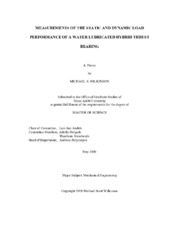| dc.description.abstract | After a successful static load testing campaign in 2015, the thrust bearing test rig has been reconfigured for dynamic load tests to determine force coefficients (stiffness, damping, and added mass). Continuous lubrication flow is supplied by a new, closed-loop water supply system capable of a wide range of operating conditions and long duration testing with little waste. In addition, a fully-instrumented loading system enables simultaneous static and dynamic (impact) loading. Cumulatively, these changes enable reliable dynamic load testing while maintaining full static load test functionality. The test rig is equipped to produce experimental results to validate bearing force coefficient model predictions. Static force vs. displacement measurements are taken to validate test rig performance after modification to accommodate the new loading and water supply systems. Overall static load results match well with predictions as well as prior experimental results. Axial clearance (C0) increases as the TTB lubrication pressure (Ps) increases. With a constant supply pressure (Ps), however, the test TB axial clearance (C0) decreases as the applied axial load (W/A) increases. Large uncertainties, due in part to the allowable run out of the thrust collar (±10µm), continue to plague axial displacement measurements. Dynamic load tests are then performed for moderate shaft speed (up to 6krpm) and quantified with force coefficients derived from the system complex dynamic stiffness function. Measurements indicate that the test thrust bearing shows no appreciable change in dynamic force coefficients (axial stiffness, damping and inertia) for the range of rotor speeds examined herein. This behavior proves the bearing behaves in a mainly hydrostatic mode as it lacks hydrodynamic features that capitalize on bearing surface speed for performance. In contrast, with an increase in applied static load at constant supply pressure the test bearing stiffness and damping increase while added mass does not show appreciable change. Finally, an increase in supply pressure under constant applied load yields an increase in stiffness and damping coefficients with no change to added mass. As with static load measurements, inherent uncertainty associated clearance measurements are large and combine with an additional error due to repeatability of the impact tests. A recommendation for future work is to fabricate a new rotor with tighter tolerances for the critical run out dimension. Lower run out tolerance will greatly reduce the clearance uncertainty, instilling better confidence in both static and dynamic experimental results. | en |


